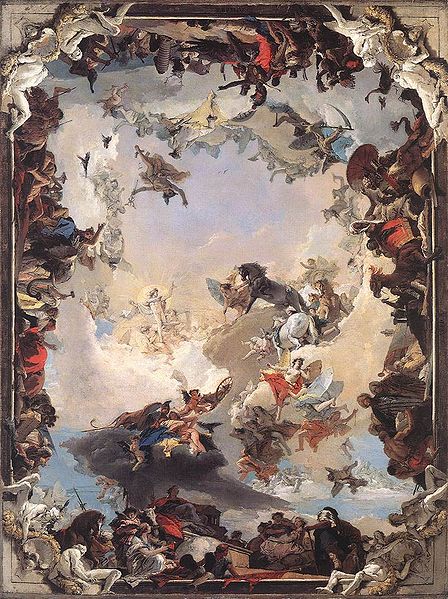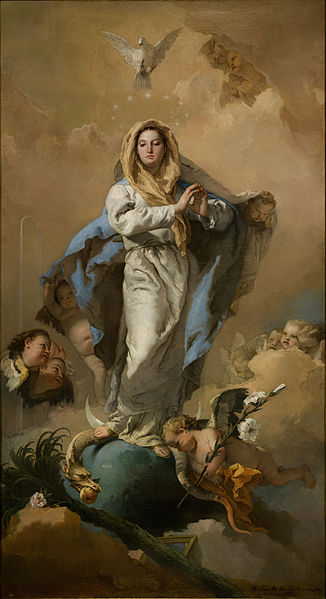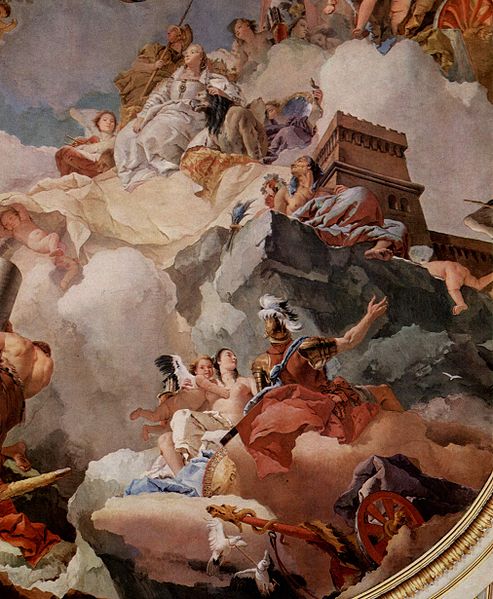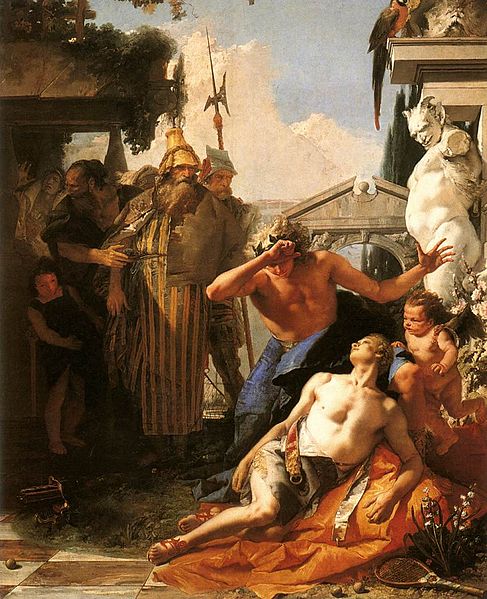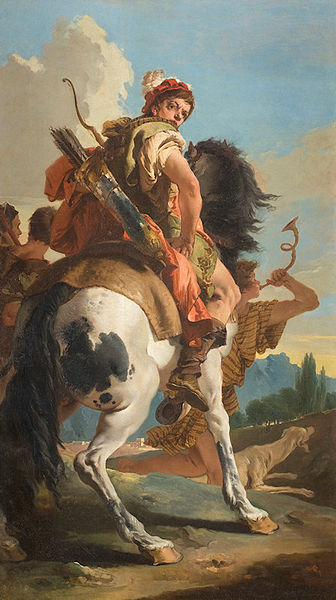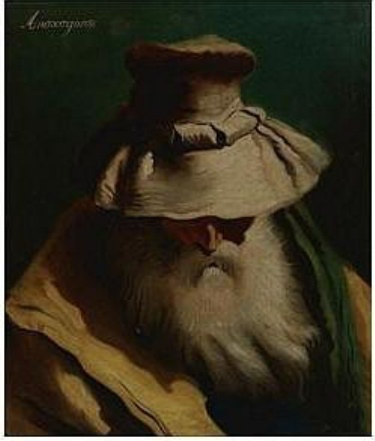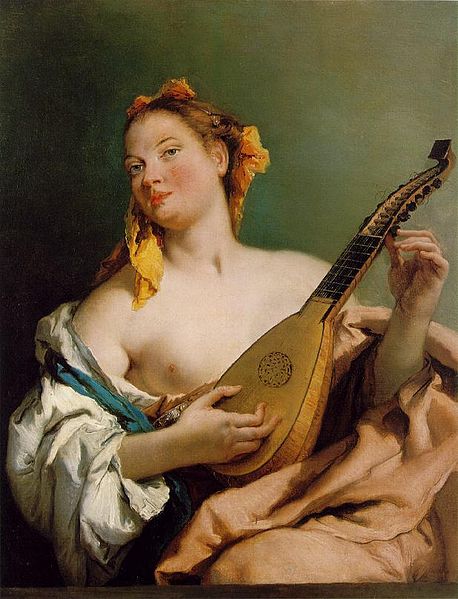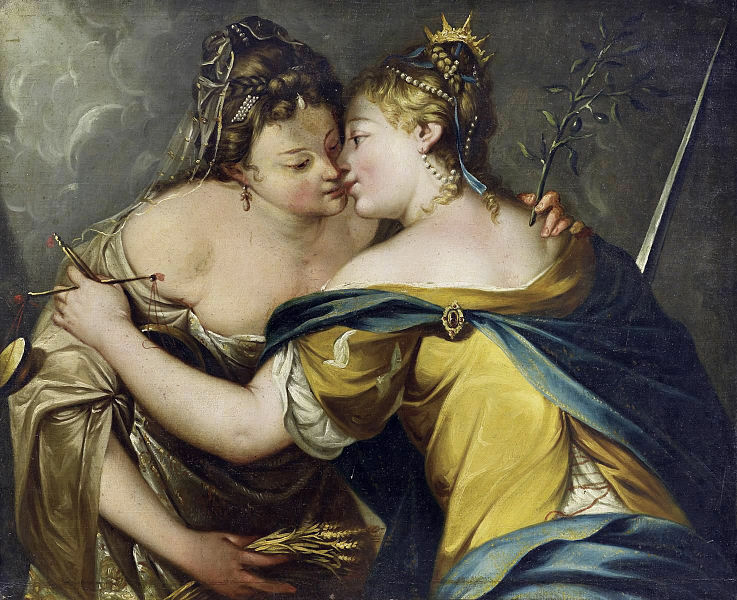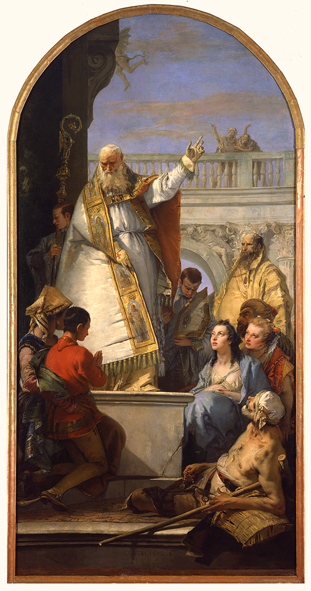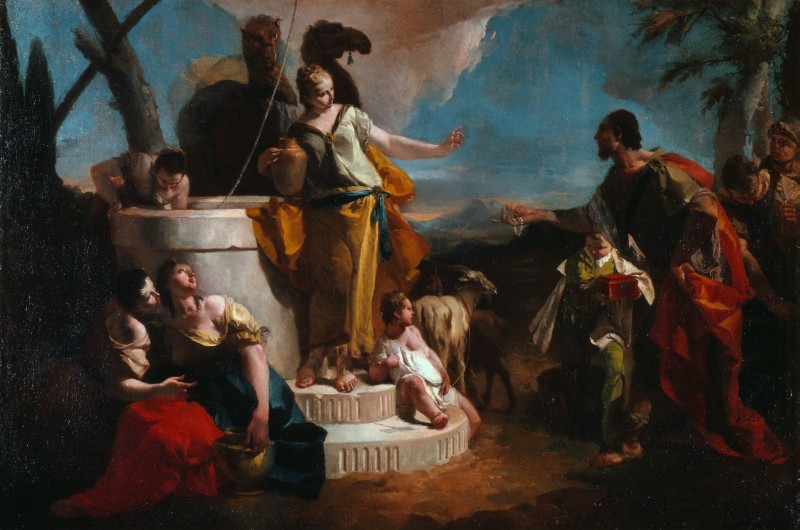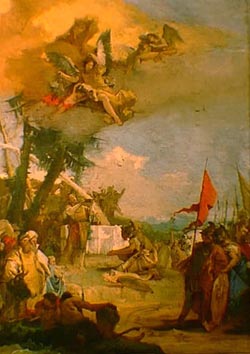<Back to Index>
- Painter Hyacinthe Rigaud, 1659
- Painter Giovanni Battista Tiepolo, 1696
PAGE SPONSOR
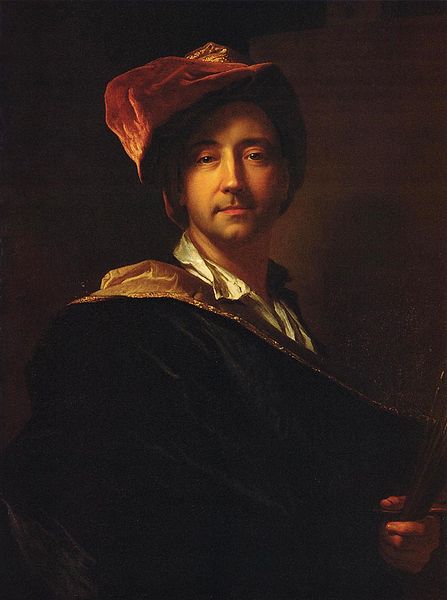
Hyacinthe Rigaud (18 July 1659 – 29 December 1743) was a French baroque painter of Catalan origin whose career was based in Paris.
He is renowned for his portrait paintings of Louis XIV, the royalty and nobility of Europe, and members of their courts and considered one of the most notable French portraitists of the classical period. For Jacques Thuillier, professor at the Collège de France:
| “ | Hyacinthe Rigaud was one of those French painters who knew the highest celebrity under the Ancien Régime. This admiration was deserved both for the surprising abundance of his work and for its constant perfection. | ” |
He was the most important portrait painter during the reign of King Louis XIV. His instinct for impressive poses and grand presentations precisely suited the tastes of the royal personages, ambassadors, clerics, courtiers, and financiers who sat for him. Rigaud owes his celebrity to the faithful support he received from the four generations of Bourbons whose portraits he painted. He garnered the core of his clientele among the richest circles as well as among the bourgeois, financiers, nobles, industrialists and government ministers, also courting all the major ambassadors of his time and several European monarchs. His œuvre reads as a near complete portrait gallery of the chief movers in France from 1680 to 1740. Some of that œuvre (albeit a minority) also includes those of more humble origins - Rigaud's friends, fellow artists or simple businessmen.
Rigaud is inseparable from his best known work, a 1701 painting of Louis XIV in his coronation costume which today hangs in the Louvre in Paris, as well as the second copy also requested by Louis XIV that now hangs at the Palace of Versailles. The exact number of paintings he produced remains in dispute, since he left a highly detailed catalog but also more than a thousand different models which specialists agree he used. To these may be added the large number of copies in Rigaud's book of accounts, without even mentioning the hundreds of other paintings rediscovered since the accounts' publication in 1919.
Hyacinthe Rigaud was born in Perpignan (Pyrénées - Orientales), the grandson of painter - gilders from Roussillon and the elder brother of another painter (Gaspard). He was trained in tailoring in his father's workshop and perfected his skills under Antoine Ranc at Montpellier from 1671 onwards, before moving to Lyon four years later. It was in these cities that he became familiar with Flemish, Dutch and Italian painting, particularly that of Rubens, Van Dyck, Rembrandt and Titian, whose works he later collected. Arriving in Paris in 1681, he won the prix de Rome in 1682, but on the advice of Charles Le Brun did not make the trip to Rome to which this entitled him. Received into the Académie royale de peinture et de sculpture in 1700, he rose to the top of this institution before retiring from it in 1735.
Since Rigaud's paintings captured very exact likenesses along with the subject's costumes and background details, his paintings are considered precise records of contemporary fashions. According to the French art historian Louis Hourticq,
| “ | On his death, Rigaud left behind a gallery of major figures with whom our imagination now populates the galerie des Glaces ; Rigaud was necessary to the 'gloire' of Louis XIV and participated in this shining of a reign whose majesty he fixed [in paint]. | ” |
True "photographs", faces that Diderot called "letters of recommendation written in the common language of all men", Rigaud's works today populate the world's major museums.
Rigaud was born with the Catalan name Jyacintho Rigau or Jacint Rigau i Ros. This is variously translated as Híacint Francesc Honrat Mathias Pere Martyr Andreu Joan Rigau – in Perpignan, which became part of France by the Treaty of the Pyrenees (7 November 1659) shortly after his birth.
Hyacinthe's father, Josep Matias Pere Ramon Rigau, was a tailor (sastre in Catalan) in the parish of Saint - Jean de Perpignan, "as well as a painter",
descended from a line of well established artists in the Perpignanian
basin who had been commissioned to decorate several tabernacles and
other panels for liturgical use. Few of these have survived to the
present (Palau - del - Vidre, Perpignan, Montalba - d'Amélie, Joch...). Hyacinthe's grandfather, Jacinto major, and even more Jacinto's father, Honorat minor, were heads of the family and the local art world from 1570 to 1630 ; probably as much as gilders as painters,
since in their studios were to be found "many prints and books treating
on the art of painting, and other things, such as brushes and palettes for painting".
Working for the collège Saint - Éloi in his city since 1560, and acting as representative of its guild of painters and gilders, on 22 November 1630 Jacinto major and other gilders and colleagues participated in the development of the statutes and minutes of the city's collège Saint - Luc . Honorat minor is generally identified as the painter of The Canonization of Saint Hyacinthe, formerly in Perpignan's Dominican convent and now at Joch, the tabernacle of the church of Palau - del - Vidre (28 March 1609) and the retable at Montalba near Amélie - les - Bains. The father of Honorat minor is generally identified as the painter of the retable at Saint - Ferréol (1623) in the église Saint - Jacques de Perpignan and formerly in the couvent des Minimes, whilst Honorat major is usually identified as the painter of the paintings of the retable of the église Saint - Jean - l'Évangéliste at Peyrestortes.
On 13 March 1647 Hyacinthe's father Matias Rigau, married Thérèse Faget (1634 – 1655), daughter of a carpenter. Widowed shortly after, he decided to speedily remarry, to Maria Serra, daughter of a Perpignan textile merchant (pentiner in Catalan), on 20 December 1655. In 1665, he acquired a house "en lo carrer de las casas cremades" (now rue de l'Incendie, near the cathedral) and received the income from a parcel of vineyards in the Bompas territory. By his second marriage, he also acquired a house on place de l'Huile, but he soon sold it.
Rigaud was baptized with his Catalan name in the old cathédrale Saint - Jean de Perpignan
on 20 July 1659, two days after his birth at rue de la Porte -
d'Assaut. He would not have become French had not Roussillon and the
Cerdanya been annexed to France the following 7 November thanks to the
Treaty of the Pyrenees. That Treaty also put an end to the wars that had
taken place between France and Habsburg Spain since 1635 and married
King Louis XIV of France to the infanta Maria Theresa of Spain.
Unfortunately, little is known about Rigaud's activities in Lyon, due to the lack of surviving documents. However, as per tradition, artists from Montpellier had strong ties with this city, as had, for example, Samuel Boissière who was trained in there, in Lyon. The identity of Rigaud's future depicted models shows that he worked for the city's cloth merchants, whose flourishing trade had long since given the city its profitable income.
Even if they had only been registered from 1681 onwards, the date when he moved to Paris, his "youthful" portraits were probably pre-dated, like those of Antoine Domergue, the king's councillor and provincial governor of Lyon, in 1686, and "Mr Sarazin de Lion", of a famous dynasty of bankers of Swiss origins, in 1685. Rigaud's portrait of Jean de Brunenc, painted in 1687, a silk merchant, banker and consul of Lyon, assembles all the ingredients for which the painter was later successful.
In her thesis on the engravers from the Drevet family, Gilberte Levallois - Clavel revealed certain aspects of the private relations between Rigaud and Pierre Drevet; their friendship came about at the beginning of the 1700s, after the painter produced a portrait of the engraver, in which he depicted himself as well.
In 1681, when Hyacinthe Rigaud decided to move to Paris, inspired by Drevet who was also attracted to the capital, he had already established a good reputation amongst the local clientele, from Switzerland to Aix - en - Provence.
In 1682, he was awarded the Prix de Rome. Going back to the
artist's biographie, Dezallier d'Argenville
states that one of Rigaud's main reasons for his 1695 voyage was to
paint his mother's portrait: "He painted her from many angles, and had
her marble bust made by the notable Coysevox,
which was his cabinet's ornament for the rest of his life". In his
first will, dated 30 May 1707, the artist left the bust to the Grand
Dauphin, Louis XIV's son, though the sculpture would then be left to the
Academy which explains its presence in the Louvre.
Also in the document, Rigaud bequeathed the portrait containing the two
profiles of Maria Serra to the elder son of his brother Gaspard, named Hyacinthe.
In reality, Rigaud painted a second painting, bearing the three stances presented to Coysevox: an oval painting kept in a private collection, copied by Géricault, in Dijon, and the subject of one of Drevet's engravings. He also applied sketches of his sister Claire, accompanied by her husband and their first daughter, to the canvas.
The year 1695 also saw the production of two versions of Christ expiant sur la Croix, with a distinct Flemish influence, proof of Rigaud's rare incursion into the domain of historical depictions or the "great genre". He bequeathed his mother the first version which would then, at her death, be left to the Grands Augustins convent in Perpignan, and gave the second, in 1722, to the Dominican convent of his city of birth.
In spring 1696, Hyacinthe Rigaud returned to Paris, where he painted one of his most important portraits of the year. This was in fact sollicited by the duke of Saint - Simon, to depict Armand Jean le Bouthillier de Rancé, an abbot, using a skillful subterfuge that remains notable in the history of painting.
In 1709 he was made a noble by his hometown of Perpignan. In 1727 he was made a knight of the Order of Saint Michael.
Rigaud painted many important figures in the world of art such as the
sculptors Desjardins, to whom, as an old friend, he delivered three
successive portraits, Girardon and Coysevox; the painters Joseph
Parrocel, La Fosse and Mignard; the architects De Cotte, Hardouin -
Mansart and Gabriel. He also painted portraits of poets such as La
Fontaine or Boileau, as well as religious figures such as the cardinal
de Fleury and Bossuet; many influential archbishops and bishops paid
large sums of money for a portrait.
Rigaud died in Paris in 1743 at the age of 84.
In 1820, the Musée des beaux - arts Hyacinthe Rigaud in Perpignan, France, was dedicated to him. It is still open to the public and shows some of his work.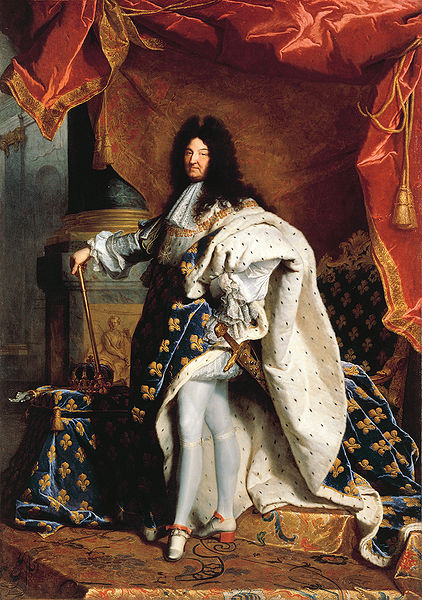
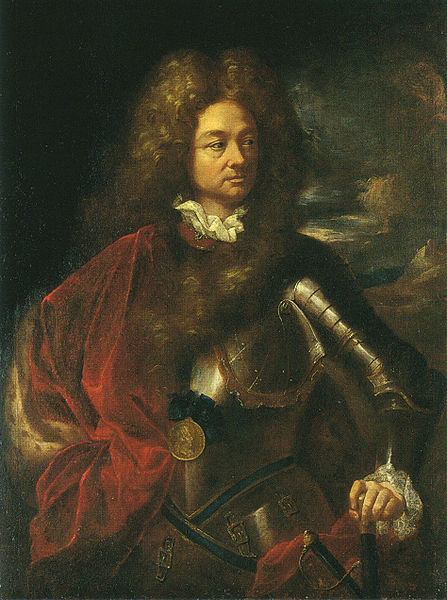
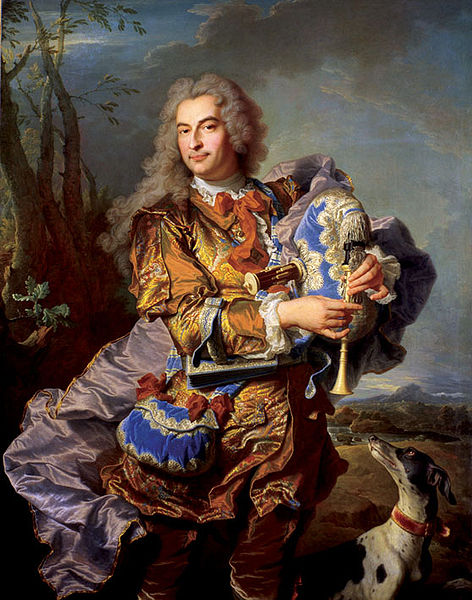
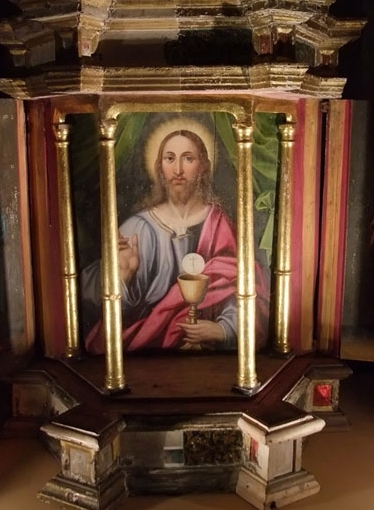
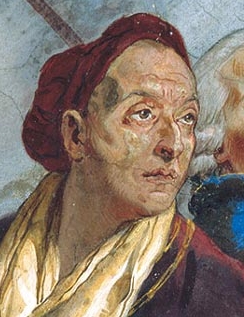
Giovanni Battista Tiepolo (March 5, 1696 – March 27, 1770), also known as Gianbattista or Giambattista Tiepolo, was an Italian painter and printmaker from the Republic of Venice. He was prolific, and worked not only in Italy, but also in Germany and Spain.
Born in Venice, Tiepolo was the youngest of six children born to Orsetta, Tiepolo's mother and his father, Domenico Tiepolo, a sea captain. While the Tiepolo surname belongs to a patrician family, Giambattista's father did not claim patrician status. The future artist was baptized in his parish church (San Pietro di Castello) as Giovanni Battista, in honor of his godfather, a Venetian nobleman called Giovanni Battista Dorià. His father Domenico died a year after his birth, leaving Orsetta in difficult financial circumstances.
Giambattista was initially a pupil of Gregorio Lazzarini, but the influences from elder contemporaries such as Sebastiano Ricci and Giovanni Battista Piazzetta are stronger in his work. At 19 years of age, Tiepolo completed his first major commission, the Sacrifice of Isaac (now in the Accademia). He left the Lazzarini studio in 1717, and was received into the Fraglia or guild of painters.
In 1719, Tiepolo was married to Maria Cecilia Guardi, sister of two
contemporary Venetian painters Francesco and Giovanni Antonio Guardi.
Together, Tiepolo and his wife had nine children. Four daughters and
three sons survived childhood. Two sons, Domenico and Lorenzo, painted
with him as his assistants and achieved some independent recognition.
His third son became a priest. Fabio Canal was one of his pupils.
A patrician from the Friulian town of Udine, Dionisio Delfino, commissioned a fresco decoration of the chapel and palace from the young Tiepolo (completed 1726 – 1728). Tiepolo's first masterpieces in Venice were a cycle of enormous canvases painted to decorate a large reception room of Ca' Dolfin on the Grand Canal of Venice (ca. 1726 – 1729), depicting ancient battles and triumph.
These early masterpieces, novel for Venetian frescoes in their luminosity, brought him many commissions. He painted canvases for churches such as that of Verolanuova (1735 – 1740), for the Scuola dei Carmini (1740 – 1747), and the Chiesa degli Scalzi (1743 – 1744; now destroyed) in Cannaregio, a ceiling for the Palazzi Archinto and Casati - Dugnani in Milan (1731), the Colleoni Chapel in Bergamo (1732 – 1733), a ceiling for the Gesuati (Santa Maria del Rosario) in Venice of St. Dominic Instituting the Rosary (1737 – 1739), Palazzo Clerici, Milan (1740), decorations for Villa Cordellini at Montecchio Maggiore (1743 – 1744) and for the ballroom of the Palazzo Labia, now a television studio in Venice, showing the Story of Cleopatra (1745 – 1750).
By 1750, Tiepolo's reputation was firmly established throughout Europe,
with the help of his friend Francesco Algarotti, an art dealer, critique
and collector. That year, at the behest of Prince Bishop Karl Philip
von Greiffenklau, he traveled to Würzburg where he arrived in November
1750. He resided for three years and executed ceiling paintings in the
New Residenz
palace (completed 1744). He frescoed the Kaisersaal salon in
collaboration with his sons, Giandomenico and Lorenzo and then invited
to deliver a design for the grandiose Neumann - designed entrance staircase (Treppenhaus). It is a massive ceiling fresco at 7287 square feet (677 m2), and was completed in November 1753. His Allegory of the Planets and Continents
depicts Apollo embarking on his daily course; deities around him
symbolize the planets; allegorical figures (on the cornice) represent
the four continents Europe, Asia, Africa and America. He included a
self portrait beside a portrait of his son Giandomenico in the Europe section of this fresco.
Tiepolo returned to Venice in 1753. He was now in demand locally, as well as abroad where he was elected President of the Academy of Padua. He went on to complete theatrical frescoes for churches; the Triumph of Faith for the Chiesa della Pietà; panel frescos for Ca' Rezzonico (which now also holds his ceiling fresco from the Palazzo Barbarigo); and paintings for patrician villas in the Venetian countryside, such as Villa Valmarana in Vicenza and an elaborate panegyric ceiling for the now nearly vacant Villa Pisani in Stra.
In celebrated frescoes at the Palazzo Labia, he depicted two frescoes on the life of Cleopatra: Meeting of Anthony and Cleopatra and Banquet of Cleopatra, as well as a central ceiling fresco depicts Triumph of Bellerophon over Time. He collaborated with an expert in perspective, Girolamo Mengozzi Colonna.
Colonna who also designed sets for opera highlights the increasing
tendency towards composition as a staged fiction in his frescoes. The
architecture of the Banquet fresco also recalls Veronese's Wedding at Cannae.
In 1757, he painted the altar piece commissioned by the family Thiene,
the work represents the apotheosis of Saint Cajetan, the altar piece is
in the church of hamlet of Rampazzo in the Camisano Vicentino.
In 1761, Charles III commissioned Tiepolo to create a ceiling fresco to decorate the throne room of the Royal Palace of Madrid. The panegyric theme is the Apotheosis of Spain and has allegorical depictions recalling the dominance of Spain in the Americas and across the globe. In Spain, he incurred the jealousy and the bitter opposition of the rising champion of Neoclassicism, Anton Raphael Mengs.
Tiepolo died in Madrid on March 27, 1770.
After his death, the rise of stern Neoclassicism and the post revolutionary decline of royal absolutism led to the slow decline of the Tiepolo style, but had failed to dent his reputation. By 1772, Tiepolo's son was sufficiently famous to be documented as painter to Doge Giovanni Cornaro, in charge of the decoration of Palazzo Mocenigo a San Polo.
Works of Tiepolo were exhibited between July 26 and September 29 1979 at
the Palazzo Ducale Museum in Venice, Italy. The exhibition was
cataloged and published the same year in the book Tiepolo, Tecnica E
immaginazione by George Knox.
In his most fluid elaborations, Tiepolo has closest affinity to Ricci, Piazzetta, and Federico Bencovich. He is a shadowless fresco artist, a sunnier rococo Pietro da Cortona. His sumptuous historical set - pieces are enveloped in a regal luminosity. He is principally known for his fresco work, particularly his panegyric ceilings. These followed the Baroque tradition begun a century before by Pietro da Cortona, converting roof to painted sky, elevating petty aristocrats to divine status, and allowing for vast compositions that merged with the delicate ornamentation of the stucco frames. Like Luca Giordano, his palette was muted, almost water color like. Like Giordano, he was prolific. With an unrivaled Sprezzatura, he painted worlds of fresco, and some such as the walls of Villa Valmarana in Vicenza, not only peer into the mythologic scenes, but are meant to relocate viewers into their midst. The earliest example of this is perhaps his canvases in the Ca' Dolfin, which allowed Tiepolo to introduce exuberant costumes, classical sculpture, and action that appears to spill from the frames into the room. Originally set into recesses, they were surrounded with frescoed frames.
While his painting is infused with the Venetian spirit, his luminosity is not seen in the previous masters; however, Tiepolo is considered the last "Olympian" painter of the Venetian Republic. Like Titian before him, Tiepolo was an international star, treasured by royalty far afield for his ability to depict glory in fresco.
His children painted figures with a design similar to that of their father, but with distinctive, including genre, styles.
